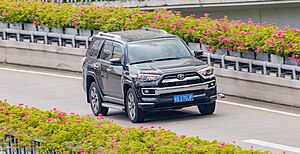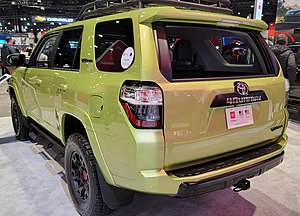Toyota 4Runner
Toyota 4Runner SUV ce da kamfanin kera motoci na Japan Toyota ke ƙera kuma ana sayar da shi a duniya tun 1984, a cikin tsararraki biyar. A Japan, an sayar da ita a matsayin Toyota Hilux Surf kuma an cire shi daga kasuwa a cikin 2009. Asalin 4Runner ɗin ya kasance ƙaramin SUV kuma kaɗan fiye da motar ɗaukar hoto Toyota Hilux tare da harsashi na fiberglass akan gado, amma samfurin ya sami ci gaba mai zaman kansa mai mahimmanci zuwa giciye tsakanin ƙaramin ƙaramin SUV da matsakaicin girman. Dukkanin 4Runners an gina su a Japan a masana'antar Toyota a Tahara, Aichi, ko kuma a masana'antar Hino Motors (tashar Toyota) a Hamura .
|
automobile model (en) | |
 | |
| Bayanai | |
| Ƙaramin ɓangare na |
sport utility vehicle (en) |
| Mabiyi |
Toyota Trekker (en) |
| Ta biyo baya | Toyota Fortuner |
| Manufacturer (en) | Toyota |
| Brand (en) | Toyota |
| Powered by (en) |
Injin mai da diesel engine (en) |
| Shafin yanar gizo | toyota.com… |







Mawallafin marubuci Robert Nathan ne ya ƙirƙira sunan "4Runner" tare da kamfanin talla na Saatchi & Saatchi a matsayin wasan kwaikwayo akan kalmar "na gaba". Hukumar ta gudanar da gasar ne domin kirkiro sabbin sunayen motocin Toyota masu zuwa. A cewar Toyota, "4" ya bayyana tsarin tuƙi mai ƙafa 4 na motar yayin da "Mai Gudu" ya kasance mai nuni ga iyawar ta gaba ɗaya da kuma yadda za ta iya "gudu" a kan hanya.
Ga wasu kasuwanni, an maye gurbin Hilux Surf a cikin 2005 ta irin wannan Fortuner, wanda ya dogara ne akan dandalin Hilux .
As of 2021[update], the 4Runner is marketed in the Bahamas, Bolivia, Canada, Chile, Colombia, Costa Rica, El Salvador, Guatemala, Panama, Peru, the United States and Venezuela.
4Runner ya shigo a lamba biyar a cikin binciken 2019 da iSeeCars.com ya yi a matsayin motocin da ke dawwama a cikin Amurka. 4Runner yana da 3.9 bisa dari na motocin sama da 200,000 miles (320,000 km), bisa ga binciken.
First generation (N60; 1983)
gyara sasheFor the first generation N60 series Hilux Surf and export specification 4Runner introduced in 1983, Toyota, instead of developing an entirely new model, modified the existing Hilux (N50/N60/N70) with short-bed pickup body. The Hilux had undergone a major redesign in 1983 for the 1984 model year. Compared to the pickup, the Surf/4Runner changes included the removal of the panel with integrated rear window from behind the front seats, and adding rear seats, a roll bar, and a removable fiberglass canopy.[1][2]
The concept was borrowed from both the second generation Ford Bronco, and the Chevrolet K5 Blazer, which were both based on existing short-bed pickup trucks with the addition of removable fiberglass shells over the rear sections and bench seats installed in the back. Like the Bronco and the Blazer, the Hilux Surf/4Runner also removed the rear wall behind the front seats in the corresponding pickup trucks. In that sense, all three vehicles were more modified than simply adding a fiberglass shell to conventional pickup trucks.[3]:88
Thus, the first generation is nearly mechanically identical to the Toyota Hilux 4×4.[1][4] All first generation 4Runners had two doors and were indistinguishable from the pickups from the dashboard forward. Nearly all changes were to the body behind the B-pillar; in fact, because the rear springs were not upgraded to bear the additional weight from the rear seats and fiberglass top, early models tended to suffer from a sagging rear suspension.
History
gyara sasheIn North America, they were sold for the 1984½ model year starting from May 1984. For this first year (March to July 1984 production), all models were equipped with black or white fiberglass tops. The base (DX) model omitted the rear seat.[5]:205 An SR5 trim package was offered that upgraded the interior: additional gauges, better fabrics, and a rear seat were standard with the package.[6] All 1984½ models were equipped with the carbureted 2.4 L 22R I4 engine, paired with a 5-speed manual transmission; all were available with a four-wheel-drive system that drove the front wheels through a solid front axle with manual locking hubs.[6]
The Hilux Surf was offered in two trim lines (SR and SSR), with either a 2.0 L 3Y gasoline or 2.4 L 2L diesel engine.[7]
Model year 1985 (which began production in August 1984) saw the arrival of the electronically fuel-injected 2.4 L 22R-E (and 22R-EC with California emissions controls). This increased the power output from 96 hp (72 kW) for the 22R[5]:204 to 116 hp (87 kW) for the 22R-E,[6] though the carbureted engine remained available until 1988. Additionally, rear seats were available in all 1985 4Runner trim levels, not just the more upscale SR5.
For model year 1986, the Surf/4Runner underwent a major front suspension design change as it was changed from a solid front axle to the Hi-Trac independent front suspension.[8] Track width was also increased by three inches. These changes made the trucks more comfortable on-road, and improved stability and handling. The new suspension also increased the space in the engine compartment (necessary to fit larger engines, such as the V6 introduced in 1987) but arguably decreased the truck's off-road capabilities. The North American specification Toyota Pickup also adopted this new suspension,[9] but the regular Hilux for other markets at this point retained the more rugged and capable, if less refined, solid axle configuration. With the 1986 update, the Surf/4Runner grille changed from the three segment type to the two segment grille. Tops were color-matched on blue, red and some gold models, while other body colors were still sold with black or white tops.
A turbocharged version of the 22R-E engine (the 22R-TE) was also introduced in the 1986 model year,[8] increasing output to 135 hp (101 kW),[10]:78 although this engine is significantly rarer than the base 22R-E. With the 22R-TE, the 4Runner was rated at 17 mpg‑US (14 L/100 km) on the city driving cycle; testing showed real-world economy was 14.5 mpg‑US (16.2 L/100 km).[10]:78 It appears that all turbocharged 4Runner models sold in the US were equipped with an automatic transmission, though a five-speed manual could still be ordered in the turbocharged pickups. Most turbocharged 4Runners were equipped with the SR5 package, and all turbo trucks had as standard a heavier rear differential later used in the V6 model. Low-option models had a small light in the gauge cluster to indicate turbo boost, while more plush vehicles were equipped with an all-digital gauge cluster that included a boost gauge.[10]:76 Turbocharged and naturally aspirated 2.4 L 2L-T and 2L diesel engines were also available in the pickups at this time as well,[9][11]:1–9 but it appears that no diesel-powered 4Runners were imported to the United States.
During 1984 to 1986 many 4Runners were imported to the US without rear seats. With only two seats the vehicle could be classified as a truck (rather than a sport vehicle) and could skirt the higher customs duties placed upon sport and pleasure vehicles.Samfuri:Clarify Most had aftermarket seats and seat belts added by North American dealers after they were imported.
| colspan=2 Samfuri:Diagonal split header | 84 | 85 | 86 | 87 | 88 | 89 | |
|---|---|---|---|---|---|---|---|
| 22R I4 | Samfuri:Yes C | Samfuri:No X | Samfuri:No X | Samfuri:No X | Samfuri:No X | Samfuri:No X | |
| 22R-E I4 | Samfuri:No X | Samfuri:Yes C | Samfuri:Yes C | Samfuri:Yes C | Samfuri:Yes C | Samfuri:Yes C | |
| 22R-TE I4 turbo | Samfuri:No X | Samfuri:No X | Samfuri:Yes C | Samfuri:Yes C | Samfuri:No X | Samfuri:No X | |
| 3VZ-E V6 | Samfuri:No X | Samfuri:No X | Samfuri:No X | Samfuri:No X | Samfuri:Yes C | Samfuri:Yes C | |
| Transmissions | 5M | Samfuri:Yes C | |||||
| 4A | Samfuri:No X | ||||||
No changes were made for the 1987 model year.[12] In 1988, the 22R-TE engine was replaced by an optional 3.0 L V6 engine, the 145 hp (108 kW) 3VZ-E,[8] available with the SR5 trim package;[13]:164 the standard engine remained the 22R-E. By this time, the SR5 package added automatic locking front hubs for both the I4 and V6 engines.[14]:160 The V6 engine was significantly larger and more powerful although not as reliable as the original 4-cylinder offering. Trucks sold with the V6 engine were equipped with the same heavy duty rear differential that was used in the turbocharged trucks, as well as a completely new transmission and transfer case; the transfer case was chain driven, although considered less rugged, created less cab noise than the old gear-driven unit used behind the four-cylinder engine.
In New Zealand, the 4Runner was equipped with the 3Y 2.0 L I4 engine instead, followed more rarely by the 4Y 2.2 L gasoline engine in later versions. This was a decision by Toyota New Zealand to reduce parts required to be stocked by dealers as no other Toyotas sold in New Zealand at the time utilised the R series engines. The 3Y/4Y also were equipped, albeit rarely, in the Japanese domestic market pickups and never were used in the US market.
Small cosmetic and option changes were made in 1988 for the 1989 model year, but the model was left largely untouched in anticipation of the replacement model then undergoing final development.[15]:116
SECOND GENERATION (N120/N130)
gyara sasheTHIRD GENERATION
gyara sashefourth generation
gyara sashefifth generation
gyara sashesixth generation
gyara sashe- ↑ 1.0 1.1 Hartford, Bill (June 1984). "Imports & Motorsports: Toyota 4Runner". Popular Mechanics. p. 10. Retrieved 9 June 2023.
Toyota took the 103-in.-wheelbase pickup, cut out the back of the cab, built in a rollbar (note the wide B-pillar) and then bolted on the plastic cap. The handsome cap is equipped with a convenient electric tailgate window.
- ↑ Taylor, Rich (October 1984). "The Best of the Ski Cars". Skiing. pp. 154–156. Retrieved 9 June 2023.
The 4Runner is basically the best-selling Toyota pickup truck fitted with a removable cap over the bed, a backless cab, and seats for five. The top unbolts and lifts off, bringing a whole new dimension to these already useful vehicles.
- ↑ Dunne, Jim (September 1987). "'88 Sport Utility Buyer's Guide". Popular Mechanics. pp. 84–89. Retrieved 9 June 2023.
- ↑ Henry, Ed; Miller, Sherri (April 1988). "Utility Vehicles: Suburban Chic". Changing Times. pp. 29–35. Retrieved 9 June 2023.
- ↑ 5.0 5.1 Knepper, Mike (December 1984). "Ski Vehicles III: The Invulnerables". Ski. pp. 201–207. Retrieved 8 June 2023.
- ↑ 6.0 6.1 6.2 Kilpatrick, Bill (May 1985). "Toyota's New 4x4". Field & Stream. p. 133. Retrieved 8 June 2023.
- ↑ "New Hilux 4WD: American Offroad Machine [1st generation]" (in Japananci). Toyota Motor Corporation. Retrieved 30 April 2024.
- ↑ 8.0 8.1 8.2 Peek, Jeff (5 September 2019). "The rise of 1984–89 Toyota 4Runners can't be ignored". Hagerty. Retrieved 8 June 2023.
- ↑ 9.0 9.1 "Toyota Cars & Trucks (full-line brochure)" (PDF). Toyota Motor Sales U.S.A., Inc. February 1986. Retrieved 8 June 2023.
- ↑ 10.0 10.1 10.2 "PM Comparison Test: Off-Road Warriors". Popular Mechanics. September 1986. pp. 74–78, 114.
- ↑ Toyota trucks, 1970–88 Repair Manual. Radnor, Pennsylvania: Chilton Book Company. 1994. ISBN 0-8019-8578-1. LCCN 93-074297.
- ↑ Hartford, Bill (February 1987). "Imports: Sports/Utility Stampede". Popular Mechanics. Retrieved 8 June 2023.
- ↑ Lamm, John (October 1987). "The Snow-Goers: 19 for the road". Ski. pp. 156–160, 164–165. Retrieved 9 June 2023.
- ↑ Lamm, John (December 1988). "Put Yourself In Traction". Ski. pp. 146–160. Retrieved 8 June 2023.
- ↑ Taylor, Rich; Millen, Rod; Hussey, Ron (photographer) (March 1989). "Sport/Utility: Dirt Rods". Popular Mechanics. pp. 113–120. Retrieved 9 June 2023.
Even though Toyota's Pickup is all-new for 1989, the 4Runner is still built off the previous Pickup chassis/body, though a mid-'89 update is due.